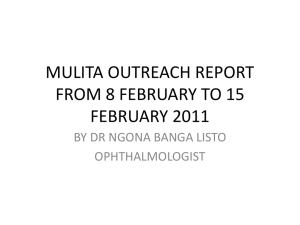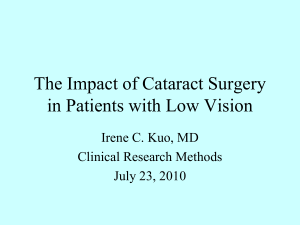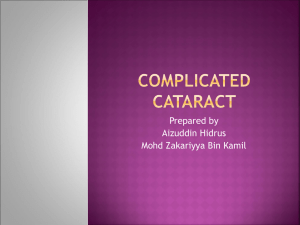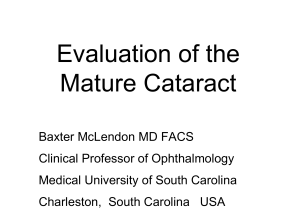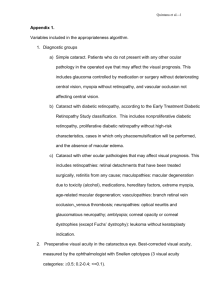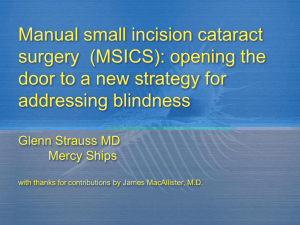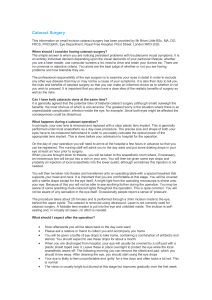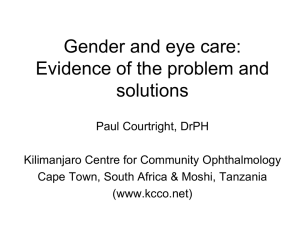RESEARCH PROPOSAL AJA September 8 SM
advertisement
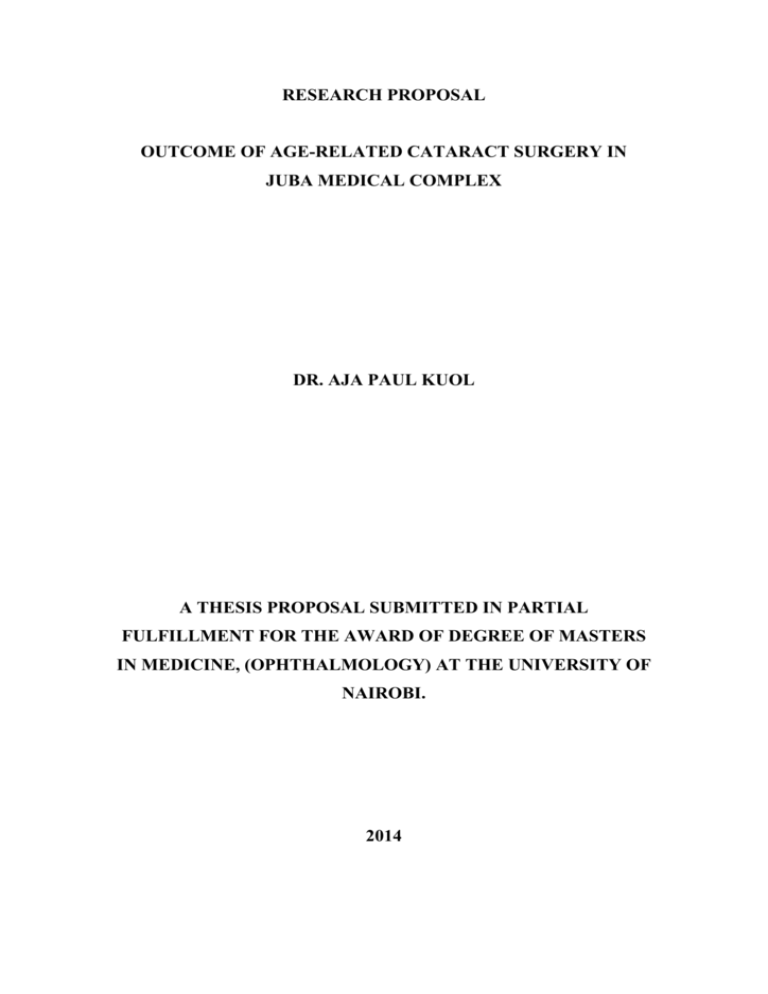
RESEARCH PROPOSAL OUTCOME OF AGE-RELATED CATARACT SURGERY IN JUBA MEDICAL COMPLEX DR. AJA PAUL KUOL A THESIS PROPOSAL SUBMITTED IN PARTIAL FULFILLMENT FOR THE AWARD OF DEGREE OF MASTERS IN MEDICINE, (OPHTHALMOLOGY) AT THE UNIVERSITY OF NAIROBI. 2014 DECLARATION I declare that this research proposal is my original work and has never been published or presented for a degree in any other University. Dr Aja Paul SIGNATURE ……………................ DATE……………….. PRINCIPAL INVESTIGATOR, Dr. Aja Paul Kuol Department of Ophthalmology, University of Nairobi H58/63241/2013 SIGNATURE …………………………… DATE……………………………… ii APPROVAL BY SUPERVISORS: This proposal has been submitted with our approval as Supervisors: 1. Dr. Sheila Marco MB.CHB, M.Med (Nairobi), FEACO, Ophthalmologist (Glaucoma specialist) Signature. .……………………………………… Date ………………………… 2. Prof. Jefitha Karimurio, MB.CHB, M.MED (Nairobi), MSC-CEH (London), FEACO, PhD (Melbourne) Department of Ophthalmology, University Of Nairobi Signature………………………………… Date …………………………… 3. Dr.Wani Gindalang Mena, MBChB, MMED (Harari) Msc, ClinEpi Consultant Ophthalmologist, Head of Eye Unit, Juba Teaching Hospital-S.Sudan Signature………………………………… Date …………………………… iii TABLE OF CONTENTS DECLARATION .......................................................................................................... ii APPROVAL BY SUPERVISORS: ............................................................................. iii LIST OF ABBREVIATIONS AND ACRONYMS ...................................................... v ABSTRACT ..................................................................................................................vi 1.0 INTRODUCTION ................................................................................................... 1 1.1 Overview of cataract ............................................................................................ 1 1.2 Epidemiology ....................................................................................................... 2 1.3 Cataract Surgery in South Sudan ......................................................................... 3 2.0 LITERATURE REVIEW ........................................................................................ 5 2.1 Outcome of cataract surgery ................................................................................ 5 3.0 JUSTIFICATION .................................................................................................. 11 4.0 OBJECTIVES OF THE STUDY ........................................................................... 12 4.1 Main Objective................................................................................................... 12 4.2 Specific Objectives ............................................................................................ 12 5.0 MATERIAL AND METHODS ............................................................................. 13 5.1 Study Area ......................................................................................................... 13 5.2 Study Design ...................................................................................................... 14 5.3 Study Population: ............................................................................................... 14 5.4 Case Definition: ................................................................................................. 14 5.5 Target population ............................................................................................... 14 5.6 Sample Size........................................................................................................ 15 5.7 Study Period ....................................................................................................... 15 5.8 Inclusion Criteria ............................................................................................... 16 5.9 Exclusion Criteria .............................................................................................. 16 5.10 Data Collection ................................................................................................ 16 5.12 Data Management and Analysis ...................................................................... 17 5.12 Ethical Considerations ..................................................................................... 18 5.13 Study Limitations ............................................................................................. 18 6.0 REFERENCES ...................................................................................................... 19 7.0 APPENDICES ....................................................................................................... 23 7.1 APPENDIX I: QUESTIONNAIRE ................................................................... 23 7.2 APPENDIX II: W.H.O. CLASSIFICATION OF BLINDNESS ...................... 26 7.3 APPENDIX III: DEFINITION OF TERMS...................................................... 27 7.4 APPENDIX IV: WORK PLAN ......................................................................... 28 7.5 APPENDIX V: BUDGET.................................................................................. 29 iv LIST OF ABBREVIATIONS AND ACRONYMS BCVA Best corrected visual acuity ECCE Extra-capsular cataract extraction ICCE Intra capsular cataract extraction IOL Intra ocular lens JMC Juba Medical Complex VA Visual Acuity WHO World Health Organization v ABSTRACT Background: According to World Health Organization (WHO), cataract is the leading cause of blindness and visual impairment throughout the world. WHO target is to eliminate cataract as one of blinding disease by 2020. Most age related cataract surgery outcomes are poor in sub-Saharan Africa due to patient selection, poor surgical techniques or uncorrected refracted errors among others. In Juba, there are a lot of cataract surgeries being done. As time goes, the number of patients waiting for cataract surgery is predicted to increase. Further, there is no current published study finding with regard to age related cataract surgery. It’s therefore necessary to conduct a study on the outcome of age-related cataract. Objective: To determine the outcome of age related cataract surgery at Juba Medical Complex from March 2011 to March 2014. Study design: A retrospective hospital based case series Study population: Any patient 40 years of age and above who underwent age related cataract surgery in Juba Medical Complex within the study period. Materials and methods: Data will be extracted from theatre registers and from the files of patients aged 40 years old and above who had age related cataract surgery. All the necessary socio- demographic and clinical data of the patient will be captured using a standardized structured questionnaire and analyzed using STATA Version 13. Descriptive analysis will be used to determine means, frequencies and proportions of the various variables. Proportionate test will be used to compare proportions. Chisquare will be used to test factors associated with poor outcome. Results will be presented in form of tables and graphs. vi 1.0 INTRODUCTION According to World Health Organization (WHO), cataract is the leading cause of blindness and visual impairment throughout the world with approximately 50% of the world's blind suffer from cataract.1 Most cases of blindness in the world are avoidable and preventable. WHO VISION 2020 targets elimination of cataract as one of blinding diseases by 2020 since its preventable.2 Most age related cataract surgery outcomes are poor in sub-Saharan Africa due to a number of factors such as poor patient selection, poor surgical techniques among others.3 The number of people undergoing cataract surgery of the past years has been increasing rapidly hence the need to investigate the outcomes of the cataract surgeries being performed. It’s therefore necessary to conduct a study on the outcome of age-related cataract. 1.1 Overview of cataract Cataracts are cloudy patches that develop in the lens of your eye and can cause blurred or misty vision.1,2,4 A cataract can occur in either or both eyes and cannot spread from one eye to the other. Most cataracts are related to aging and are very common in older people, but there are other types of cataract due to other factors and they include traumatic cataract, congenital cataract, radiation cataract etc1,5,6 Cataract is usually detected through a comprehensive eye exam which includes visual acuity test, dilated eye exam and tonometry.6,7 The symptoms of early cataract may be treated or improved with new eyeglasses, brighter lighting, anti-glare sunglasses, or magnifying lenses. However, when these measures do not help, surgery becomes the only effective treatment.7,8. Cataract surgery is a procedure which involves removal of cloudy natural lens and replacing it with a clear optical device such as an intraocular lens (IOL) or contact lenses. This is a technique which prevents the blindness from occurring. Some of the cataract surgeries include: Phacoemulsification (phaco), Extracapsular Cataract Extraction (ECCE), Intracapsular Cataract Extraction (ICCE) and Small Incision Cataract Surgery (SICS) among others.7,8,9,10 Risk factors for age-related cataract include diabetes, prolonged exposure to sunlight, tobacco use and alcohol drinking among others.1,6,11 1.2 Epidemiology The prevalence of age-related cataract varies from region to region. Globally, the estimated number of blind people is about 39 million and approximately 82% of people living with blindness are aged 50 years and above. Surgical removal of the cataract is still the current effective treatment that is available to prevent the blindness.12 There are an estimated 39 million blind people and 285 million visually impaired people worldwide and about 90% of people who are visually impaired live in developing countries.13 Unoperated cataract contributes to 33% of the global causes of visual impairments. About 65% of all people who are visually impaired are aged 50 and older and this constitutes 20% of worlds population. In developed countries, for each decade after the age of 40 there is an expected increase in the prevalence of blindness and vision loss.13 According to WHO, life expectancy in South Sudan is low (54/55 years) because of the long civil war that the country had and majority of the patients develop cataract at younger age around 40 years. 2 In Sub-Saharan Africa the prevalence of blindness in people over the age of 50 is as high as 9%, and cataract is responsible for more than 50% of this blindness.14 About 7.1 of the world's 38 million blind people live in sub-Saharan Africa with 60% of Africa's blind being women and 50% of blindness in sub-Saharan Africa is due to cataract.14 The prevalence of blinding cataract in sub-Saharan Africa is approximately 0.5%.14 Cataract is the leading cause of blindness in the world: in 1998, an estimated 20 million people were blind due to cataract.15 Globally, at least 100 million eyes have visual acuity <6/60 due to cataract and the need for cataract operations is at least 30 million per year, but only around 10 million cataract operations are performed annually.16 1.3 Cataract Surgery in South Sudan In South Sudan, access to cataract surgery may still be a challenge to many patients due to factors such as lack of knowledge/ awareness, lack of funds or specialized practitioners and the techniques. So far the private medical center in south Sudan where cataract surgery is done is the Juba Medical Complex (JMC) which may not be adequate to cover the larger population of 350,000 (Sudan 2008 census).17 The cataract surgery is done by the consultant ophthalmology and the type of surgery done is ECCE. And the center (JMC) is in operation with only one ophthalmologist, one ophthalmic nurse and one nurse assistant Juba Medical Complex is one of the main eye hospitals in South Sudan serving a larger number of populations since so far there less than 10 ophthalmologists in the region. Cataract surgery is increasingly being performed in the hospital with up to 350 cases of cataract surgeries have been done between 2011 and 2014. The number is 3 quite low because cataract surgery in the hospital is too expensive for the people to afford. This study will review the outcome of age related cataract surgery in patients aged 40 years and above at Juba Medical Complex for the period between March 2011 and March 2014. It will be the first such study in the hospital and will provide a baseline for future comparisons, provide appropriate recommendations and guide future training of Ophthalmologists in age-related cataract surgery. 4 2.0 LITERATURE REVIEW 2.1 Outcome of cataract surgery Outcome of cataract surgery is an important factor to be looked at since complications problems can arise after surgery. These problems can include infection, bleeding, inflammation (pain, redness, swelling), loss of vision, double vision, and high or low eye pressure.4,18,19 With prompt medical attention, these problems can usually be treated successfully. In South Sudan, generally there are no reported studies on the outcome of surgery and specifically outcome of age related cataract surgery. However, there are other studies which have looked at outcomes of cataract surgery and complications. WHO recommends that poor (best corrected visual acuity [BCVA] <6/60) or borderline (BCVA <6/18) outcomes after cataract surgery should not be more than 10% to 20%. Several studies have attributed poor cataract surgery outcomes to late presentation, poor surgical techniques and loss to follow up among others.18 Others have attributed the poor cataract surgery outcomes due refractive errors, post-operative complications and due to other diseases such as glaucoma or corneal scleral or even traumatic cataract for age related cataract surgery.10,18,19,20 This study will also study age related cataract surgery outcome for those aged 40 years and above. These complications may occur in about 6% of cataract surgeries cases in the developing world.8 Poor results due to surgical complications can be limited through continuous training and visual outcome monitoring.11 Cook reviewed a study on how to improve the outcomes of cataract surgery in the year 2000. In the study, they noted poor outcome may be due to ‘selection’ (other 5 pathology), ‘surgery’ (intra-operative complications), and ‘spectacles’ (uncorrected refractive error), or ‘sequelae’ (post-operative complications).18 The study recommended that in order to improve the outcome of cataract surgeries the individual cataract surgeons should monitor their intra-operative complications and the visual outcome of their surgery. In addition, the programme managers must ensure that there is adequate training of cataract surgeons. In this study therefore we shall also assess the possible causes of poor outcomes after cataract surgery. Thulasiraj et al assessed the clinical outcomes of cataract surgery in rural southern India of persons aged 50 years and above was conducted. The study found that within the cataract-operated sample of 682 persons, 13.8% had presenting visual acuity worse than 6/60 in both eyes, 25.2% better than or equal to 6/18 in both eye. For aphakic eyes, 50.5% presented with visual acuity better than or equal to 6/18; 82.6% with best-correction. The study noted that uncorrected aphakia and other refractive error were the main causes of vision impairment.10 In this study we will also identify for eyes with presenting visual acuity worse than 6/18 for principal cause of reduction in eye vision. Domple et al conducted a study on visual outcomes after cataract surgery with intraocular lens implant at rural health training Centre in India. The study assessed the visual outcomes of patients after cataract surgery with intraocular lens implants with reference to visual acuity (VA) and visual function (VF) in order to assess patient satisfaction with surgical outcome. 50% patients had VA in fair vision range of <6/18-6/60 and 52% showed the VF in the range of 76-100. Of the 32 satisfied patients, majority were in the age group 70-79 years.21 This study, however, did not 6 show the potential causes of poor visual outcomes after age-related cataract surgery which we shall try and address in our study Bourne et al conducted a study to evaluate the outcomes of cataract surgery in Pakistan in the year 2007 among the adults aged 30 years and above. The study assesse 1317 patients and found that more recent ICCE surgeries were associated with a poorer outcome. The study noted that almost a third of cataract operations resulted in a presenting VA of <6/60, which could be halved by appropriate refractive correction. The study highlighted the need for an improvement in quality of surgery with a more balanced distribution of services.22 Salomão et al conducted a study on prevalence and outcomes of cataract surgery in Brazil. The study found out that among the 352 cataract-operated eyes, 41.2 % presented with VA >6/12, 28.1% with VA 6/12 to 6/18, 14.2% with VA 6/18 to 6/60, and 16.5% with VA <6/60. The study noted that with best correction, the percentages were 79.5%, for vision better than 6/18, 8.2%, and 12.2% respectively. The main cause of vision impairment or blindness in operated eyes were refractive error and retinal disorders.23 Lai et al investigated clinical outcomes of cataract surgery in very elderly adults aged 90 years and above who underwent cataract surgery. The study found out that most common complications were vitreous loss (8.2%), posterior capsular rupture (7.2%), and zonular rupture (4.8%). Participants with Age-related macular degeneration (AMRD) and vitreous loss were less likely to achieve postoperative visual improvement. The study noted that despite a high prevalence of systemic and ocular 7 comorbidities in very elderly adults, good clinical outcomes of cataract surgery were attainable.24 This study will investigate the clinical outcomes of age-related cataract surgery in Juba. Malik et al. conducted a study on visual outcomes after high volume cataract surgery in Pakistan in 2002. In their study 181 patients aged 45–82 years who had undergone cataract surgery were examined. The type of cataract operations examined were extracapsular cataract extraction (ECCE), phacoemulsification (phaco), ECCE with intraocular lens (IOL) and phaco with IOL. The study found out that functional vision in eyes undergoing ECCE with IOL was good in 77% and phaco with IOL in 71.8%. Uncorrected refractive error, present in 75.5%, was the commonest cause of poor functional vision.20 The study noted that more attention should be directed towards ensuring that successful outcomes are indeed being realized by continued visual monitoring postoperatively. The study, however, was not able to access data on preoperative visual acuity and ocular findings. In this study we will assess if good visual results are possible due to the types of the surgical techniques and try access data on preoperative visual acuity and ocular findings. Bastawrous and Sherwin conducted systematic reviews of blindness and visual impairment due to age-related cataract in sub-Saharan Africa. They reviewed population-based studies published between 2000 and October 2012 for patients aged 50 years and above from 15 countries. The study found out that cataract was the principal cause of blindness and visual impairment. There was a strong positive correlation between good visual outcomes and IOL use. In this study, we shall assess the relationship between the surgical techniques and the visual outcomes.25 The study 8 noted that there was no data that was available from countries such as South Sudan when they were evaluating age-related cataract surgery in sub-Saharan Africa in 2013 Chirambo conducted initial study to develop monitoring systems for cataract outcome in Malawi in the year 2000. The study found out that 19.5% poor visual outcome at the time of discharge and that most cases of poor outcome were attributed to surgery, particularly post-operative corneal oedema.26 This study will assess the outcomes attributed to age-related cataract surgery in Juba, South Sudan. Bejiga and Tadesee assessed cataract surgical coverage and outcome in Goro District, Central Ethiopia. The study found out that presenting and corrected visual acuities of 6/18 or better were obtained in 23.7% and 47.4% of the operated eyes respectively. The major cause of poor visual outcome found was surgery related complications in 61.1% of the cases.27 The visual outcome after cataract surgery was however lower than the recommended WHO visual outcome. Trivedy conducted a study on the Outcomes of high volume cataract surgeries at a Lions Sight First Eye Hospital in Kenya. The study found out that there was no significant association between pre-operative visual acuity, surgeon, time of surgery and post-operative uncorrected visual acuity (UCVA) of 6/18 and better. Postoperative examination done at day 30 did not reveal any anterior segment complications in all the eyes operated. The study concluded that high quality cataract surgery can be attained in a high volume setting.9 9 Bitok et al conducted a study on the outcome of age-related cataract surgery at Sabatia Eye Hospital from the year 2011 to 2012. The study found that the main causes of poor visual outcome included refractive errors, poor patient selection and surgical complications and concluded that the visual outcome is below the WHO set standard.28 Nganga et al conducted a study on the outcome of age-related cataract surgery at Light House for Christ Eye Centre in Mombasa from the year 2009 to 2011. The study found out that the post-operative BCVA at 7 weeks post-operative was found to be slightly below the recommended WHO guidelines. The intra-operative surgical complications were found to be within the recommended WHO guidelines. The study concluded that Lack of surgical complications was shown to be statistically significant in contributing to good visual outcome post-operative. (p-value= 0. 008).29 Monday et al conducted a study on patterns of ocular findings among patients aged 40 years and above attending eye clinic at Juba Teaching Hospital in South Sudan. The study found that cataract was the second most causes of ocular morbidity in the population aged 40 years and above (21%). The study didn’t not mention if the cataract was age-related and not age-related, and did not investigate the outcomes of the age-related cataract for patients aged 40 years and above.30 The review of literature shows no published findings for age-related cataract surgery in south Sudan. 10 3.0 JUSTIFICATION It is very important to carry out ongoing and continuous audits in eye hospital in order to know both the visual and surgical outcomes of the surgeries that have been done. This study will be able to establish the outcome of age related cataract surgery in the center and consequently in the whole region of South Sudan. Studies have shown that poor outcomes due to age-related cataract surgery are common in developing countries. This will also assist the hospital and its management in monitoring its performance towards improving the outcome of cataract surgery in the region. It will provide the baseline information for the subsequent researchers that are done in the same field of study The study, which was conducted in south Sudan on the patterns of ocular morbidity among the patients aged 40 years and above, found that cataract was the second most cause of ocular disease. This study only mentioned cataract in general and didn’t specify the type of cataract was found 11 4.0 OBJECTIVES OF THE STUDY 4.1 Main Objective To assess the outcome of age related cataract surgery in patients aged 40 years and above performed at Juba Medical Center between March 2011 and March 2014. 4.2 Specific Objectives 1. To assess the visual outcomes of age-related cataract surgery 2. To determine the complications of age-related cataract surgery 3. To determine the factors associated with poor surgical outcome. 12 5.0 MATERIAL AND METHODS 5.1 Study Area Fig 1: A map showing Juba Medical Centre, Juba The study will be carried out at the Juba Medical Complex in Juba, South Sudan. It is located in the capital of South Sudan Juba; which is located in Central Equatorial State, one of the ten states of the South Sudan, with a catchment area of about 150 km/s with population of 350,000 (Sudan 2008 census). The eye unit operates once a week with frequency of patient ranging between 10 -20 per Day and ranging from 3600 to 7000 per Year in all age groups but frequency of patients going for cataract surgery ranging between 2 to 10per day and to approximately 700 to 3600 per year (JMC eye unit statistic-2014). 13 Juba Medical Complex (JMC) in Juba is a sixty bed Hospital established to plug a yawning gap in the provision of high quality secondary and tertiary care in the Southern Sudan. Juba Medical Complex has 5 separate blocks: pharmacy, theater, maternity, wards, and the main block. At JMC there is only one ophthalmologist consultant who does all the eye surgeries and only one ophthalmic nurse. 5.2 Study Design This will be a retrospective hospital based case series. 5.3 Study Population: Records of all persons age 40 and above went for cataract surgery at JMC. 5.4 Case Definition: Any patient aged 40 years and above who had under gone cataract surgery for age related cataract between March 2011 to March 2014 at Juba Medical Center. 5.5 Target population An estimated number of 350 patients have undergone age-related cataract surgery at Juba Medical Complex between March 2011 and March 2014 (from the Juba Medical Complex records). 14 5.6 Sample Size The following sample size determination formula for finite population correction (Lwanga & Lameshow, 1991)31 was used to estimate the proportion of population study size. n' NZ 2 P(1 P) d 2 ( N 1) Z 2 P(1 P) Where n' = sample size with finite population correction, N = size of the target population = 350 (estimated number of patients who have undergone age-related cataract surgery according to the Juba Medical Centre theatre registry book between March 2011 to March 2014) Z = statistic for 95% level of confidence P = estimated proportion of patients with poor age-related surgical outcome – 4.2%3 d = margin of error = 2.1% n 350 1.962 0.042 0.958 175.38 175 (0.0212 349) (1.962 0.042 0.958) n' = 175 patients 5.7 Study Period The study will be conducted from December 2013 to December 2014. 15 5.8 Inclusion Criteria All the records of persons 40 years and older who had age related cataract surgery at the centre will be eligible to be included in the study. 5.9 Exclusion Criteria Missing or incomplete records (age ,VA) Record of all persons less than 40 years at the time of surgery Cataract secondary to trauma Uveitic cataract 5.10 Data Collection Structured questionnaires (Appendix I) will be used by the principal investigator assisted by a research assistant to record/ collect patients’ data. The file/card number of patients over 40 years who underwent cataract surgery between March 2011 and March 2014 will be recorded from the theatre surgery record books, the files will then be retrieved from the hospital registry with the assistance of the hospital records clerk and the data recorded in the questionnaire. Information that will be collected will include: Demographics, preoperative examination information (visual acuity, refraction, visual complaints, other diseases that may affect the outcome), Surgery (Date, time and surgeon qualifications, anaesthesia given, Surgical techniques, and intra operative complications), Post-operative examination (discharge date, visual acuity, possible cause of poor vision, examination at day 1, 1st follow up, 2nd follow up, 3rd follow up and 4th follow-up, and complications after surgery. Data collection period will be between December 2014 and January 2015 16 5.12 Data Management and Analysis The collected data will be entered into the computer, cleaned, validated and coded using STATA version 13 (Stata Corp, College Station, Texas). It will be checked for any wrong entry and double entry and corrected. Back up will be created in an external hard disk in case of damage and/or loss of original data and it will be password protected. All data will be stored under lock and key and with password protected files under the custody of the principal investigator to prevent any illicit access to the data. Use of coded data will be done to ensure maximum confidentiality. At the end of the study, the raw data will be destroyed and deleted from any existing hard copies by paper shredding and formatting and deleting from any soft copy storage devices including computers, flash discs and hard disks. \.\ Data analysis Data analysis will be done using the STATA version 13 (Stata Corp, College Station, Texas). Descriptive analysis will be done to determine means, frequencies and proportions of the various variables and findings presented by means of graphs, tables and charts where appropriate. Proportionate test will be used to compare proportions of the categorical and continuous variables describing demographics, Preoperative examination, surgery and post-operative examination. Chi-square will be used to test factors associated with poor outcome. Confidence level will be taken as 95% (p <0.05) where applicable. 17 5.12 Ethical Considerations The identity of the patients will be keep anonymous during data collection. No record of the identity of the patient or file number will be made. No photocopies of medical records will be made. The questionnaires will only be available to the Biostatistician and investigator for analysis only. Written ethical approval to conduct the study will be sought from the Ethics and Research Committee of University of Nairobi and Kenyatta National Hospital for approval. Approval will also be sought from Juba Medical Complex and Ministry of Health in South Sudan for approval The raw data will be retain in confidentiality until the thesis has been accepted and marked for any verification and/or study published and maximum of 1 year after ethical approval. The questionnaires and other materials shall then be destroyed. 5.13 Study Limitations The retrieved information from the private health facility (JMC) may not be sufficient for the study to make inference about the whole of south Sudan. 18 6.0 REFERENCES 1. World Health Organization, Global initiative for the elimination of avoidable blindness, 2000, [Online], Available: http://www.who.int/inf-pr- 2000/en/pr2000-27.html, [Accessed 27 05 2014]. 2. WHO. VISION 2020, Global Initiative for the elimination of avoidable blindness -Action Plan 2006-2011 [Internet]. WHO; 2007. Available from: www.who.int [Accessed 27 May 2014] 3. Ahmad S. Visual outcome of cataract surgery in a field hospital of subSaharan Africa. Pakistan Armed Forces Medical Journal. 2011;61(2):246-50 4. Chitkara D. Cataract Formation Mechanisms In: Yanoff M, ed. Ophthalmology: Mosby 1999:4.8.3-4.8.4 5. World Health Organization. International Statistical Classification of Diseases and Related Health Problems: Chapter 7. 2007 [cited 5 May 2014]; Available from: http://www.who.int/classifications/apps/icd/icd10online/ 6. Kuszak J. Pathology of age-related human cataracts. In: Tasman W, ed. Duane's Clinical Ophthalmology. 2004 ed: Lippincot, Williams & Wilkins 7. Johansen J, Theodorsen FP, Corydon L. Visual outcome following complicated extracapsular cataract extraction. J Cataract Refract Surg 1992; 18: 577–81. 8. Gogate PM, Deshpande M, Wormald RP, et al. Extracapsular cataract surgery compared with manual small incision cataract surgery in community eye care setting in western India: a randomised controlled trial. Br J Ophthalmol. 2003; 87(6): 667-672. 9. Trivedy J. Outcomes of high volume cataract surgeries at a Lions Sight First Eye Hospital in Kenya. Nepal J Ophthalmol. 2011;3(1):31-38. 19 10. Thulasiraj RD, Reddy A, Selvaraj S, et al. The Sivaganga Eye Survey: II. Outcomes and Cataract Surgery. Ophthalmic Epidemiology 2002; 9,(5):313– 324. 11. Yorston D. Cataract Complications. Community Eye Health. 2008; 21(65). 12. World Health Organization. Global initiative for the prevention of avoidable blindness. WHO/PBL/97.61. Geneva: WHO, 1997 13. Taylor HR, Keeffe, JE. World blindness: a 21st century perspective. Br J Ophthalmol. 2001;85(3):261-6 14. Lewallen S, Courtright P. Blindness in Africa: present situation and future needs. Br J Ophthalmol. 2001;85(8):897-903 15. World Health Organization. The World Health report - life in the 21st century: a vision for all. Geneva: WHO, 1998;47 16. Foster A. Cataract-a global perspective: output, outcome and outlay. Eye. 1999;13:65-70 17. Sudan Census. National Bureau of Statistics:2008 18. Cook C. How to Improve the Outcome of a Cataract Surgery. Community Eye Health, 2000; 13(35): 37–38. 19. Lumme P, Laatikainen LT. Factors affecting Visual Outcome after cataract surgery. International Ophthalmology 1993; 17:313-319 20. Malik AR, Qazi ZA, Gilbert C. Visual outcome after high volume cataract surgery in Pakistan. Br. J. Ophthalmol. 2003;87(8):937–40. 21. Domple VK, Gaikwad AV, Khadilkar HA, et al. A study on visual outcomes after cataract surgery with intraocular lens implants at the rural health training center, Paithan, Maharashtra. Indian Journal of Public Health. 2011; 55( 1): 22-24 20 22. Bourne R, Dineen B, Jadoon Z, et al. Outcomes of cataract surgery in Pakistan: results from The Pakistan National Blindness and Visual Impairment Survey. Br J Ophthalmol. 2007;91(4):420-426. 23. Salomão SR, Soares FS, Berezovsky A, et al. Prevalence and Outcomes of Cataract Surgery in Brazil: The São Paulo Eye Study. Am. J. Ophthalmol. 2009;148(2):199–206 24. Lai FH, Lok JY, Chow PP, et al. Clinical Outcomes of Cataract Surgery in Very Elderly Adults. J Am Geriatr Soc. 2013 25. Bastawrous A, Dean WH, Sherwin JC. Blindness and visual impairment due to age-related cataract in sub-Saharan Africa: a systematic review of recent population-based studies. Br J Ophthalmol. 2013;97(10):1237-1243 26. Chirambo MC. Country-wide Monitoring of Cataract Surgical Outcomes. Community Eye Health 2002;15(44):58–59. 27. Bejiga A, Tadesse S. Cataract surgical coverage and outcome in Goro District, Central Ethiopia. Ethiop. Med. J. 2008;46(3):205–210. 28. Bitok MC, Kariuki MM, Karimurio J et al. Outcome of age-related cataract surgery at Sabatia Eye Hospital, Western Kenya. Unpublished MMED Thesis, University of Nairobi, 2013 29. Nganga MN, Kimani K, Njuguna MM et al. Outcome of age-realted cataract surgery at Light House for Christ Eye Centre, Mombasa. Unpublished MMED Thesis, University of Nairobi, 2014 30. Monday JL, Marco S, Maina N et al. Pattern of ocular findings among patients aged 40 years and above attending eye clinic at Juba Teaching Hospital in Southern Sudan. Unpublished MMED Thesis, University of Nairobi, 2014 21 31. Wanga SK, Lemeshow S. Sample size determination in health studies. A practical manual. Ginebra: World Health Organization, 1991. 22 7.0 APPENDICES 7.1 APPENDIX I: QUESTIONNAIRE TITLE OF STUDY: OUTCOME OF AGE-RELATED CATARACT SURGERY IN JUBA MEDICAL COMPLEX This questionnaire is for collecting information for the patients aged 40 years and above General Information Questionnaire code _______________ Data collection date ______________ Socio-demographics Home district/ region _____________ Gender: 1. Male Age (years) ____________ 2. Female Clinical information Operated eye 1. LE 2. RE PRE-OP EXAMINATION VA Presenting ______ Biometry Pinhole/BCVA ____ IOP ______________________ Eyelids ______________________ Conjunctiva ______________________ Cornea ______________________ NO Anterior chamber______________________ Iris _______________________ Pupil ____________________________ Yes Type of cataract: Nuclear Cataract Hypermature Cortical cataract Other PSC Vitreous _______________________________________ Fundus ________________________________________ 23 SURGERY Date _____________________________ Surgeon Consultant OCO/CS Trainee Anaesthesia LA GA Surgical technique Type IOL Suture Incision SICS Bag Yes ___ Scleral ___ ICCE Sulcus No ___ Corneal Lensectomy AC Limbal ___ Phaco.. None Superior __ ___ Temporal __ COMPLICATIONS Pre-op complications Retrobulbar haemorrhage during aneasthesea ___________________________ Other _______________________________________________ Intra-op Complications Complication Yes No None Posterior capsule tear Iris prolapse Iridodilysis Vitreous loss Suprachorodal haemorrhage Hyphema Zonular dialysis Lens matter in vitreous Other 24 Post-op Complications Complication Yes No Shallow/flat AC Elevated IOP Corneal oedema Aqueous Misdirection Cystoid macula edema PCO IOL dislocation Endophthalmitis Astigmatism Retinal detachment Uveitis Pupillary capture Other POST-OP VA Day of follow up Findings Presenting BCVA/ Pinhole Day 1 _________ _________ Follow-up 2 (___weeks) _________ _________ Follow-up 3 ( ___weeks) _________ _________ Follow-up 3 (____weeks) _________ _________ Follow-up 4 (_____weeks) _________ _________ ___________________ _________ _________ Main cause of poor Outcome at last visit Selection _______________________________________________ Surgery ________________________________________________ Refraction_______________________________________________ Sequelae _______________________________________________ 25 7.2 APPENDIX II: W.H.O. CLASSIFICATION OF BLINDNESS Category Degree of visual impairment Best corrected visual acuity in the better eye 0 Normal vision 6/6 - <6/18 1 Visual impairment 6/18 –< 6/60 2 Severe visual impairment 6/60 -<3/60 or visual field < 10 ̊ 3 Blind 3/60 –NPL or visual field <5 ̊ 26 7.3 APPENDIX III: DEFINITION OF TERMS Age related cataracts: Cataract occurring after 40 years of age. Best corrected visual acuity – The best achievable visual acuity after correcting for any refractive errors with spectacles, contact lenses or other corrective measures. Biometry – Measurement of the size and lens power of the eye using ultrasound measurements and formulas Cataract - Is a clouding of the crystalline lens of the eye which impedes the passage of light. Extracapsular cataract extraction – A method of eye surgery used in which the lens nucleus and cortex of the natural lens of the eye is extracted from the lens capsule in parts, after opening the anterior lens capsule. Intracapsular cataract extraction – A method of eye surgery used in which the natural lens of the eye is extracted in total without disruption of the lens capsule. Visual Acuity – The measure of vision for an eye. Poor visual outcome: visual acuity 6/60 or less (as per WHO guidelines) Moderate or Borderline visual outcome: visual acuity of <6/18 - 6/60 (as per WHO guidelines) Good visual outcome: visual acuity above or equal to 6/18 (as per WHO guidelines) 27 7.4 APPENDIX IV: WORK PLAN TIME (YEAR &MONTH 2014 2015 J F MA MJ J A S O N D J F MA M ACTIVITY Concept and Preparation of Proposal Presentation to Department Ethical Approval Budget Approval Preparation of Study materials/Training of Assistants Data collection Data Analysis and Results presentation Preparation and Submission of Thesis 28 7.5 APPENDIX V: BUDGET Item Total (Ksh) Printing and Packing 400 Photocopy of Proposal 240 Binding Proposal 360 Proposal Printing 2nd draft 400 Photocopy of proposal 2nd draft 240 Binding of proposal 2nd draft 450 Ethics: Kenya, South Sudan 5000 Sub-total 4,500 Contracted services Statistician 50,000 Research assistants 30,000 Sub-total 80,000 Communication Telephone 4,000 Miscellaneous 1,500 Subtotal 5,500 Results Printing of questionnaire 100 Photocopy of questionnaire 6,500 Printing of results 6000 Copy of final book 5000 Binding of final paper 1,700 Transportation (T&T) Nairobi-Juba-Nairobi 110,000 Juba-Juba Medical Complex- Juba 16,000 Grand total 237,890 29
